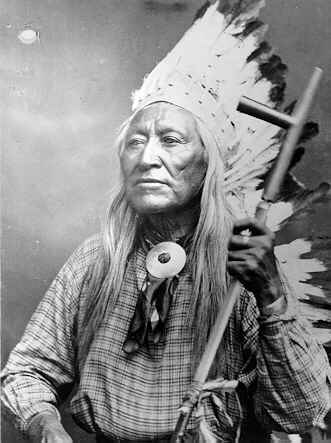

The date of
Washakie's birth is unknown, but it probably occurred during the first few
years of the 19th century. His father was a Flathead and his mother was from one
of the Shoshone tribal groups, probably a Lemhi. The future Shoshone chief was
named Pina Quanah (Smell of Sugar) when he was born.
The Flathead
village in which his family was living was attacked by Blackfeet Indians.
Washakie's father was killed. The surviving villagers scattered. Washakie's
family was eventually taken in by Lemhis. He and a sister remained with the
Lemhis even after their mother and other family members rejoined the Flatheads.
Washakie later
joined the Bannocks, a tribe hostile to white men. He lived with them five years
before joining the Green River Snake Indians, who had peaceful relations with
whites.
Washakie became a
noted warrior. Although the name by which he would be widely known has been
translated in various ways, it apparently dealt with his tactics in battle. One
story describes how Washakie devised a large rattle by placing stones in an
inflated and dried balloon of buffalo hide which he tied on a stick. He carried
the device into battle to frighten enemy horses, earning the name "The
Rattle." Another translation of Washakie is "Shoots-on-the-Run."
By 1850 Washakie
was head chief of the Shoshones, apparently earning the position by his deeds in
battle and wise counsel, though there is no record to show exactly when and
under what conditions the decision was made. It is thought that the various
Shoshone tribes may have united under one chief to deal with threats by hostile
tribes, such as the Sioux and Cheyenne.
Washakie became
an ally of white men, deciding early that warfare was pointless and a policy of
adaptation and mutual assistance should be followed. He assisted U.S. Army
operations, with military forces and advice, against hostile tribes,
particularly the Sioux and Cheyenne. Washakie granted right-of-way through
Shoshone land in western Wyoming to the Union Pacific Railroad, aiding the
completion of a coast-to-coast rail line.
The Shoshone
chief also sought the best for his people, requesting schools, churches, and
hospitals on Shoshone lands. He also pushed for a reservation in his beloved
"Warm Valley" (Wind River Valley) which had been given to the Crows, enemies
of the Shoshones, in the 1851 Fort Laramie Treaty. In 1868 the United States,
determining that the Crows had broken treaty terms, gave the valley to the
Shoshone Indians at the Fort Bridger Treaty Council. In 1896, Washakie ceded
lands bounding mineral hot springs near Thermopolis for public use, requesting
that a portion of the waters be set aside for free use by people of all races.
